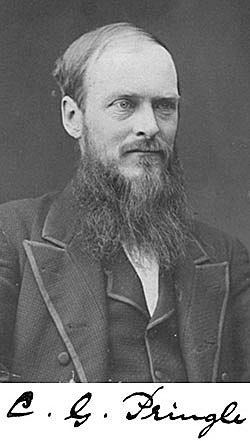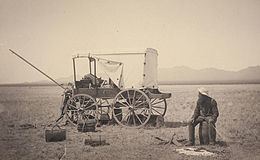Name Cyrus Pringle | Role Botanist | |
 | ||
Died May 25, 1911, Burlington, Vermont, United States Books Civil War Diary, The Record of a Quaker Conscience, Cyrus Pringle's Diary | ||
Cyrus Guernsey Pringle (May 6, 1838 – May 25, 1911) was an American botanist who spent a career of 35 years cataloguing the plants of North America. He is in the top five historical botanists for quantity of new species discovered — approximately 1,200 species, 100 varieties, twenty-nine genera, and four combinations.
Contents

Biography

He was born on May 6, 1838 in East Charlotte, Vermont. His ancestry on his father's side was Scottish Presbyterian; his maternal grandfather, Asa Harris, was of Puritan stock. He studied in Hinesburg and Bakersfield, Vermont, and later at Stanbridge, Quebec, before entering the University of Vermont in the year 1859, enrolling in the classical course. However, the death of his older brother during the first semester, made it necessary for him to aid his widowed mother in the management of the farm and to give up all ideas of college.
In the early part of his life he was interested in the Quaker religious doctrine of the Friends, and it was through these meetings that he met, and later married, on February 25, 1863, Almira L. Greene of Starksboro, Vermont, a school teacher and a speaker of the Friends.
Apples and potatoes
His first horticultural undertakings were on his mother's farm in 1857, when, at the age of nineteen, he budded a small seedling apple tree, with a large, striped, sweet summer apple.
In 1858 he started his first nursery, containing a small pear orchard, fruit yards, gardens of currants, cherries, grapes, peaches and potatoes. He made a plan for each orchard or garden, giving the name and location of each plant. By crossing, he obtained a new variety of potato seedling "No. 6 (1870)," which was called "Snowflake." This potato was introduced to the public in New York. Robert Fenn, an Englishman much interested in crossing American and English varieties of potatoes, recognized Pringle's ability and the two of them worked together on other projects, such as the crossing of "Snowflake" with "Rector of Woodstock" and vice versa.
Another cross-bred potato of 1870, "Ruby," gained a first-class certificate from the London Horticultural Society, and, with "Snowflake," was awarded a Silver Medal by the Massachusetts Horticultural Society.
He sold seedlings of lilies, gladioli and wheat. He grew more than 100 varieties of iris and nearly all the species of lilies. His Hubbard squash seeds brought a dollar a pound at one time, and he ran a "hospital" for bulbs. "People sent him their sick specimens from great distance to healthy Vermont and his skillful practice," according to Davis’s account.
Civil War
During the American Civil War, about five months after his marriage, he, along with two other Vermont Quakers, was drafted into the Union Army on July 13. They shared the Quakers' disapproval of war, and when Doctor Pringle's uncle offered to pay the $300 necessary for his release, he would not allow this to be done, regarding that solution as a selfish compromise with principle. Refusing to perform all military duty, he was subjected to severe discipline. The Friends were kept for days in the guardhouse in company with drunks and criminals. Finally, on October 3, 1863, at Culpeper, Doctor Pringle was staked to the ground, with his arms outstretched and his legs cruelly racked; he was left in this position for hours, until "so weak he could hardly walk or perform any exertion". He was even threatened with death if he would not give up, but his only reply was, "It can but give me pain to be asked or required to do anything I believe to be wrong." After a day of extreme pain he wrote in his diary, "This has been the happiest day of my life, to be privileged to fight the battle for universal peace."
When Secretary of War Stanton heard of this treatment, he ordered "the three incorrigibles" sent to Washington. Isaac Newton, Commissioner of Agriculture, went to President Lincoln about their case, and the President asked the Secretary to release them. The Secretary refused, claiming that his oath of office stood in the way of giving them a discharge. In the meantime Doctor Pringle's physical strength began to give way, and he spent most of his three weeks in Washington in bed. It was only after President Lincoln had gone personally to Stanton that the parole was granted.
After recovering his health in 1868, Pringle again turned his energies to plant breeding, attempting to hybridize new varieties of fruit and corn, tomatoes, and grains such as wheat and oats.
Collector
In 1872 Pringle's wife separated from her husband to pursue evangelistic work, and they divorced on October 16, 1877.
Sometime around the 1870s, Pringle began to collect plants throughout Vermont, from deep in mossy woods, by lakesides, or high on mountain summits. On December 13, 1874, he was appointed to the Vermont Board of Agriculture. During three successive years he took boat trips up the lower St. Lawrence, to the Saguenay (a river in Canada), and the St. Francis and St. John Rivers of northern Maine.
In 1878, he displayed many of the Vermont specimens which he had been collecting, at the Paris Exposition.
In 1880, he was named as botanical collector for the American Museum of Natural History, and as an agent for the United States Census Department, to explore the forests of that region and to collect data for a final report.
In 1884, he made a botanical survey of the north and northwestern portions of Arizona, under the auspices of the Smithsonian Institution, and this later branched into a 26-year survey of Mexico. The Mexican Herald referred to him as one of the most brilliant and scholarly men ever to grace Mexico with his presence.
During his thirty-five years of field work in the United States, Canada and Mexico, he distributed to herbaria over 500,000 specimens, embracing some 20,000 species, about 12 per cent of which were new to science.
In April, 1896, he was elected a member of the New England Botanical Club, within the first year of its existence and when in Boston attended the meetings. He became vice-president and charter member of the Vermont Botanical Club.
In the last year of his life he talked of planning a trip to South America, but died before he ever realized that dream, on May 25, 1911. He is buried in Morningside Cemetery, Charlotte, Vermont. His last name on the front of his stone is Prindle, with a plaque on the reverse Pringle.
Plants named in his honor
Plants named in his honor include:
Writing
He wrote many articles in The Country Gentleman from 1869 to 1880. For example in an 1880 issue he wrote "Origin of the Snowflake Potato." In 1884 he published Pringle's Reports on Forests of Vermont, New Hampshire, New York, Pennsylvania and West Virginia in Dr. C. S. Sargent's "Report on the Forests of North America," Census Office, 1884.
